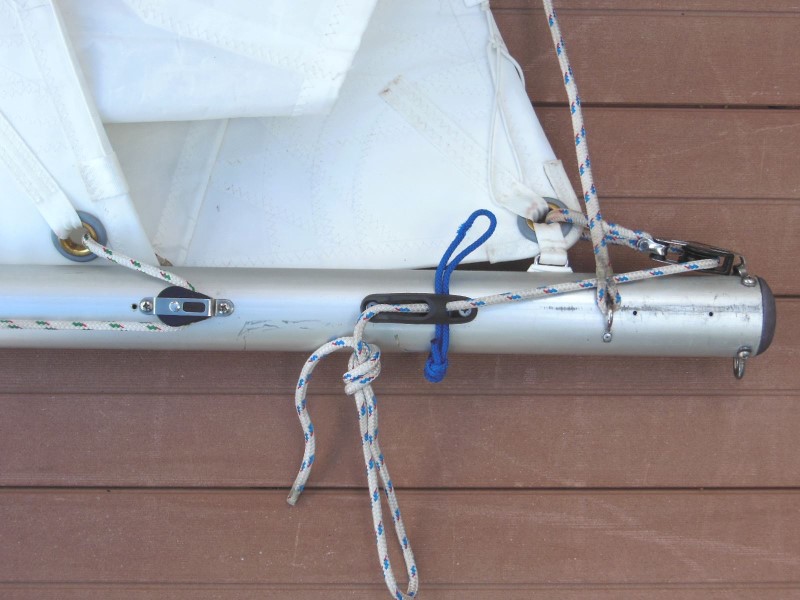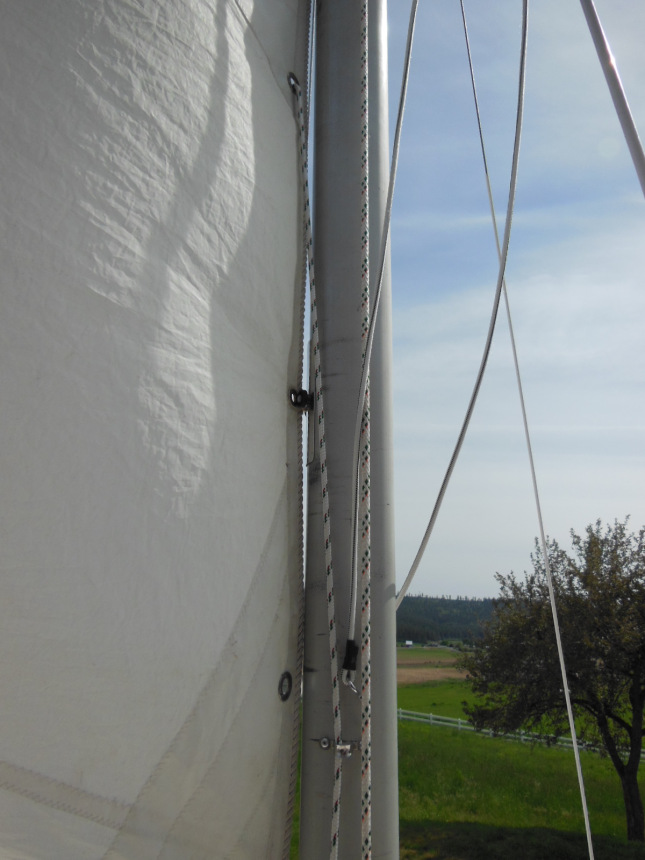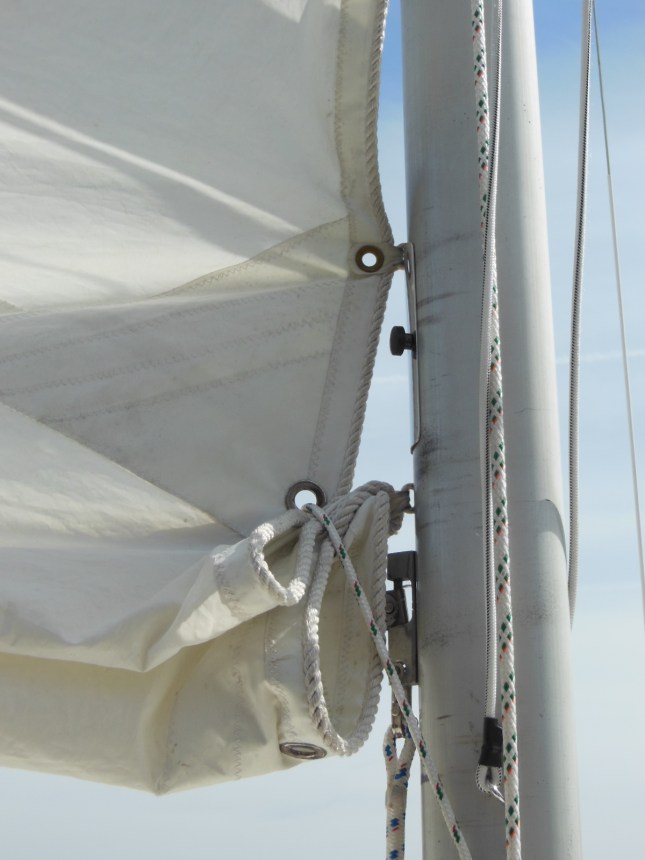Your ability to reef your mainsail is one of the most important sailing skills that you can learn. Your reefing rigging plays an important part in that. You can do it with just a few short lengths of rope but it will be more time consuming and difficult than it needs to be. That method is not very safe to use during the weather conditions when you’re most likely to need to reef. Having a system of reefing lines in place and ready to use at any time increases your ability to reef smoothly and efficiently (in a jiffy) when conditions warrant it, particularly if you sail single-handed.
Reefing systems for trailerable sailboats typically come in two types: single-line and double-line. Each type has its advantages and disadvantages. A single-line system has fewer lines to attend to, which can make it faster to use but it’s a little more complicated than a double-line system. A double-line system is a little bit simpler design but it can take more time to use. Opponents of single-line reefing will point out that a single-line system can’t pull both reef points of the sail evenly at the same time and they’re right. The luff cringle will pull tight while the leech cringle is just starting to pull down. But that doesn’t mean that it won’t still work.
Some people prefer the basic approach of double-line reefing, others prefer the speed of a single-line system. In my opinion, speed of controlling sail area is of the essence and why I prefer it. If you take the time to fully understand both types, you can choose which system is best for you. This post describes a single-line system similar to the kit sold by a certain online Catalina parts retailer. The main difference is that this system doesn’t use a hook in the luff cringle (grommet). A hook can accidentally fall out and it can chafe the mainsail. In this design, the line runs from one side of the boom to the other through the grommet on its way from the end of the boom forward through the mainsail, down the mast, and aft to the cockpit (optional).
Materials list
Here are the materials you need to complete this project:
- 45′ x 1/4″ New England Ropes Sta Set rope or equivalent, less if it will not be led aft to the cockpit
- (4) small regular eye straps & (8) #10 x 1/2″ stainless steel pan head tapping screws
- (1) small fairlead eye strap & (2) #10 x 1/2″ stainless steel pan head tapping screws
- (2) 29mm cheek blocks & (4) #10 x 1/2″ stainless steel pan head tapping screws
Installation instructions
The following steps describe where to lead the reefing line and how to install the hardware along the way. The pictures in this post show the line starting and ending on the starboard side, but either side will work, it’s your choice. Just start on the same side as where you want the line to end at a mast cleat or at the cockpit.
1. Position the mainsail on the boom where it should be after it has been reefed. This should be with both reef points (cringles) touching the top of the boom and the mainsail pulled flat between them. If you do this with the boom and mainsail removed from the sailboat, keep the mainsail luff aligned with the boom gooseneck at all times just as it would be when mounted to the mast.
2. Attach one eye strap to the boom slightly aft of where the mainsail leech meets the boom (opposite the cheek block in the picture below). Align the strap parallel to the boom and far enough aft so that the mainsail won’t bind up against the strap when you reef the sail. Attach one end of the reefing line to this strap with either a knot or a spliced eye.
3. Attach one cheek block to the boom on the opposite side of the boom from the eye strap. Align the block parallel to the boom and pointing aft. Reeve the reefing line through the aft cringle in the mainsail, then through this cheek block and forward along the side of the boom like in the picture below. When you reef the mainsail, the line should pull the cringle downward and aft without binding.

4. At the forward end of the boom, mount the other cheek block on the same side as the first cheek block. Align the block parallel to the boom and point it forward like in the picture below.

5. Mount the remaining three regular eye straps evenly spaced between the two cheek blocks. Alight them perpendicular to the boom and slightly below the boom centerline so that they straddle the reefing line when it’s tight and hold it up out of the way when it’s slack.
6. Lead the reefing line through the eye straps, through the forward cheek block, up and through the forward mainsail cringle, and then down to the opposite side of the boom.
7. Mount the fairlead eye strap on the side of the mast slightly below the boom when it’s at its normal height during a full hoist (for a C-22, the boom should be 39″ from the cabin roof to the top of the boom). In the picture below, the fairlead is mounted horizontally on the mast. I later rotated it counter-clockwise about 30 degrees to reduce friction on the line when it’s reefed.

When reefed, the line should pull the forward cringle straight down to the boom like in the picture below. The reefing line should then do the same job that the tack pin does when the mainsail is at full hoist.

Below the fairlead, you can tie the line to a jam cleat on the mast. However, that means somebody must go forward to the mast to do it. If that’s during heavy weather, it’s not safe. The alternative is to lead the line through a turning block at the mast step, to a deck organizer, and to a cleat at the cockpit, which is much safer.
How to reef
When you begin to suspect that the wind might pick up beyond what you or your boat are comfortable with, it’s time to reef the mainsail. If you have a single-line system, it’s easy to do and equally easy to undo, so do it early to be on the safe side. You can shake the reef out later if it turns out that you don’t need it. But if you fail to reef when you should, you could wind up regretting it.
First, point the boat into the wind and maintain that course until you are done reefing. This takes the pressure off of the mainsail so that you can give your full attention to safely reefing it faster and tighter. If you’re already in heavy weather, the sails will be flogging violently, which is another reason to do this at the dock during calmer weather. Also maintain sufficient forward motion (motoring, if necessary) so that the wind cannot blow the bow off course while you reef the mainsail. If you have a boom vang and it is tightened, slack it off.
Assuming you also have your main halyard led aft to the cockpit, simultaneously ease the halyard to lower the mainsail while you pull on the standing end of the reefing line. You want to do this simultaneously so that the boom doesn’t slide down the mast. To keep the first mainsail slugs from falling out of the mast, you need to either install mast gates to close the slot opening (recommended) or a jack line in the mainsail so that they can be held above the opening with a sail stop.
The boom should stay in position and the mainsail should stay relatively flat while the slack in the mainsail is gradually taken up by you pulling the reefing line. Keep pulling until the luff cringle is as low as it will go, then cleat off the halyard. At this point, the mainsail is about half reefed. The leech is only partly reefed but the line will be tight.
Now, since the boom is centered over the cockpit because you’re pointing into the wind, you can simply reach up to the boom and grab the reefing line anywhere along the length of the boom. Pull the line toward the mast with one hand while you simultaneously pull the standing end of the reefing line with your other hand. Continue hauling the reefing line this way until the leech cringle is as low as it will go. It should only take a few pulls and then you can cleat off the reefing line. Now the mainsail is fully reefed.
All that remains is to roll up and tie the slab of loose mainsail onto the boom. You should have short lengths of rope called gaskets or bunt lines already tied into the middle reef points for this. Tie them with a slip knot so that you can easily untie them. Reset the boom vang, if necessary. You can now resume sailing your original course with the mainsail depowered.
When it comes time to release (shake out) the reef, point back into the wind and reverse the process. First, untie the bunt lines. Uncleat both the main halyard and the reefing line and then ease out the reefing line while you hoist the head of the mainsail back to full height. The leech cringle won’t need any help coming loose. Cleat off the halyard and you’re done.
Would you like to be notified when I publish more posts like this? Enter your email address below to subscribe to this blog and receive notifications of new posts by email. You will also receive occasional newsletters with exclusive info and deals only for subscribers and the password to the Downloads page. It’s free and you can unsubscribe at any time but almost nobody does!


Great job – and explanation! Thanks!
Where did you get your cheek blocks? The cheapest I can find add up to more than your total cost for the project. Can you send me a list of suppliers? I like what you did. Great job and just what I need.
Hi, Howard
I bought the cheek blocks for this project from Nautos USA. I describe them and my other favorite suppliers in The 6 Best Sources for Sailboat Parts and Supplies.
Excellent. Putting pulley on the sail can reduce friction
If you want or need two reef positions, would you run a second single line system along the other side of the boom? Maybe on smaller trailer sailors, two reef points are not needed?
Here’s an idea for the less frequent sailor reading your blog who is unfamiliar with sailer/nautical terms. .. Maybe you could devise a ready-reference listing on a page for the terms (or link to another site with that info)? The first time you refer to a term in a given article, you could link to that term’s bookmark and have the description pop open in a new tab or window (with instructions to close it to return to the article)? You’d think “leech” and “luff” would be as second nature as “port” and “starboard” to me by now! LOL! Maybe that exrra mental processing will help me better remember the gist of the article…:-)
Thanks for another great write-up!
Hi, Ed
In my opinion, if the weather is bad enough for a C-22 that it needs two sets of reef points, it’s bad enough to not sail at all. The exception would be cruisers who make island passages offshore and might get caught in a really nasty blow but even then you could get by without them. If it were me, I’d opt for one reefing system for simplicity, either single-line or double-line and use reefing hooks to grab higher on the sail, if needed.
Your idea about glossary links is a good one even thought it means a bunch more work for me 😉 As a test, I edited this article and inserted a slew of links to the nautical terms glossary at Wikipedia. Try it out and let me know what you think.
Thanks!
$tingy
Thanks! That makes a lot of sense. I’ve never had any reef points on my Venture 21 main sails, so your article fit a need as I dream about my project list!. It seems I see multiple reef points on ocassion on trailered boats, so maybe it is a sales tactic. Or perhaps the designers felt their boats could benefit from several smaller reefing adjustments…
The links to terms works perfectly…for those like me who need it! Nice resource to have in my bookmarks file, too!
Cheers!
Thanks for very helpful post!
Any reason you place the cheek block near the mast on the boom? The Harken illustration of this setup shows it on the mast, to pull the sail down and forward. In your case are there any issues with the sail being pulled backward/aft by the reef line?
Either location will work but I prefer the block on the boom to keep the lead down the boom straight. It also makes the boom height less of a factor since it doesn’t need to align with the block. And it keeps the block from interfering with external halyards, lazy jacks, etc. I’ve not had any problems with not enough forward pull on the luff reef point. It’s harder to get the leech reef point down and tight.
Great explanation! Thank you. We have an O’Day Mariner, and the mainsheet halyard and topping lift are at the mast. We’re relatively novice sailors, and researching reefing methods. Can the single line reefing system still work with the standing end of the reefing line ending at the mast? I realize its not as safe (maybe we can find a way to move our halyard and topping lift to the cockpit), but am not sure from your description whether it is possible. Thanks.
Hey, Carolyn
Absolutely! The paragraph below the last photo sums it up.
Let me know if you have any more questions,
$tingy
Jiffy reefing
Great post
I am new to sailing and to the Catalina 22 world and have thoroughly enjoyed reading your website. Which size eye strap do you consider small? Something like a Harken 38mm (1.5″)? I searched for an fairlead eye strap and could not come up with anything. Do you have a reference for that part? Thanks!
Yes. Here’s an Amazon link for a similar size at lower cost: https://amzn.to/441c7m7
Thanks! I am running all lines aft to the cockpit as well. I am going to place a splice at the end of the lines for the halyards, downhaul, etc. What is the preferred attachment for the halyard to the foresail and mainsail with a splice at the end of the line? How about on the foresail down haul and spinnaker halyard? What about the boom downhaul? Thanks!
You can see the splices that I used on my running rigging in my post Choose Your Running Rigging Colors Logically at https://stingysailor.com/2022/01/29/running-rigging-color-scheme-2/
Very through post. I’m getting ready to get a new main. Do you have any thoughts/ suggestions for a reef system with a loose footed main? Does a loose footed main complicate reefing? Thanks
Hey, Greg
A loose foot makes no difference in the reefing system. Go with whatever system is most convenient for you.
Thanks for your question!